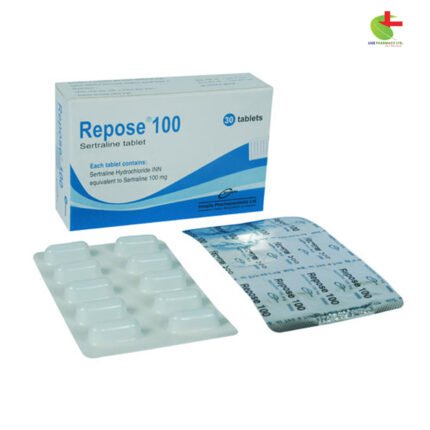Silagra 50
120.00৳ Strip
- Silagra is an effective treatment for erectile dysfunction (ED) and pulmonary arterial hypertension (PAH), containing Sildenafil, a PDE5 inhibitor.
- It helps men achieve and maintain a satisfying erection during sexual stimulation by increasing blood flow to the penis.
- Silagra is also used in managing PAH by relaxing blood vessels in the lungs. Consult a healthcare provider before use.
 Brand
Brand
|
Incepta Pharmaceuticals Ltd |
|---|---|
 Generics
Generics
|
Sildenafil Citrate |
 Type
Type
|
Tablet |
Indications
Silagra is prescribed for the treatment of erectile dysfunction (ED) in men, helping to achieve and maintain an erection sufficient for sexual performance. Sexual stimulation is required for Silagra to work effectively. It is also indicated for the management of pulmonary arterial hypertension (PAH).
Please consult a registered healthcare provider before using this medication.
Description
Silagra is a selective, reversible inhibitor of phosphodiesterase type 5 (PDE5), which plays a key role in the erectile process. Upon sexual stimulation, the body releases nitric oxide (NO), which triggers the production of cyclic guanosine monophosphate (cGMP). By inhibiting PDE5, Silagra increases cGMP levels in the corpus cavernosum, leading to smooth muscle relaxation and increased blood flow to the penile tissues, resulting in an erection. Silagra requires sexual stimulation to be effective and has no effect in the absence of such stimulation.
Pharmacology
- Mechanism of Action: During sexual arousal, nitric oxide (NO) is released, which enhances the production of cGMP, causing smooth muscle relaxation and enabling blood flow into the penis. Silagra boosts the effect of nitric oxide by inhibiting PDE5, an enzyme responsible for breaking down cGMP. This results in improved blood flow to the penile tissue when sexually stimulated.
- Metabolism and Absorption: Silagra is quickly absorbed with a bioavailability of approximately 41%. It is metabolized primarily in the liver by CYP3A4 and CYP2C9 enzymes, with a half-life of about 4 hours. Its absorption can be delayed if taken with high-fat meals.
- Excretion: About 80% of Silagra is excreted through the feces, with a smaller percentage in the urine.
Dosage & Administration
- Erectile Dysfunction: The usual starting dose is 50 mg, taken about 1 hour before sexual activity. Depending on individual response and tolerance, the dose may be adjusted to 25 mg or 100 mg. The maximum recommended dose is 100 mg, and it should not be taken more than once a day.
- Pulmonary Arterial Hypertension: The recommended dose is 20 mg three times daily, with or without food, spaced 4 to 6 hours apart.
Please consult a healthcare provider for personalized dosage recommendations.
Interactions
Silagra’s metabolism is primarily affected by CYP3A4 and CYP2C9 enzymes. Co-administration with medications that inhibit these enzymes (such as ketoconazole, erythromycin, and ritonavir) can significantly increase Silagra’s plasma concentrations, potentially raising the risk of side effects. Additionally, taking Silagra with nitrates (used for chest pain) is contraindicated as it can cause a dangerous drop in blood pressure.
Contraindications
Silagra is contraindicated for individuals who have a known hypersensitivity to any ingredient in the formulation. It should not be taken by patients using nitrates or nitric oxide donors, as the combination can lead to severe hypotension (low blood pressure).
Side Effects
Common side effects of Silagra include:
- Cardiovascular: Chest pain, dizziness, and hypotension
- Digestive: Upset stomach, nausea, and indigestion
- Nervous system: Headache, dizziness, and visual disturbances
- Skin: Rash, flushing, and sweating
In rare cases, severe side effects such as prolonged erections (priapism) or sudden loss of vision may occur. Immediate medical help should be sought if an erection lasts longer than 4 hours.
Pregnancy & Lactation
Silagra is not intended for use by women, and there are no adequate studies on its use during pregnancy. It is not recommended for use during breastfeeding as it may be excreted in breast milk.
Precautions & Warnings
- Heart Health: Silagra should be used with caution in men with underlying cardiovascular conditions, as sexual activity and vasodilation may put additional strain on the heart.
- Alpha-blockers: If you are taking alpha-blockers for hypertension, Silagra should be started at the lowest dose to avoid significant drops in blood pressure.
- Liver & Kidney Issues: Patients with liver or severe renal impairments may require a lower starting dose due to slower metabolism and increased plasma levels.
- Prolonged Erection: Seek medical help if an erection lasts more than 4 hours, as untreated priapism can cause permanent damage.
Overdose Effects
In case of overdose, supportive care should be provided as required. Silagra is highly protein-bound and not significantly removed by renal dialysis.
Therapeutic Class
- Drugs for Erectile Dysfunction
Storage Conditions
Store Silagra in a cool, dry place away from direct sunlight and heat. Keep out of reach of children.













Reviews
There are no reviews yet.